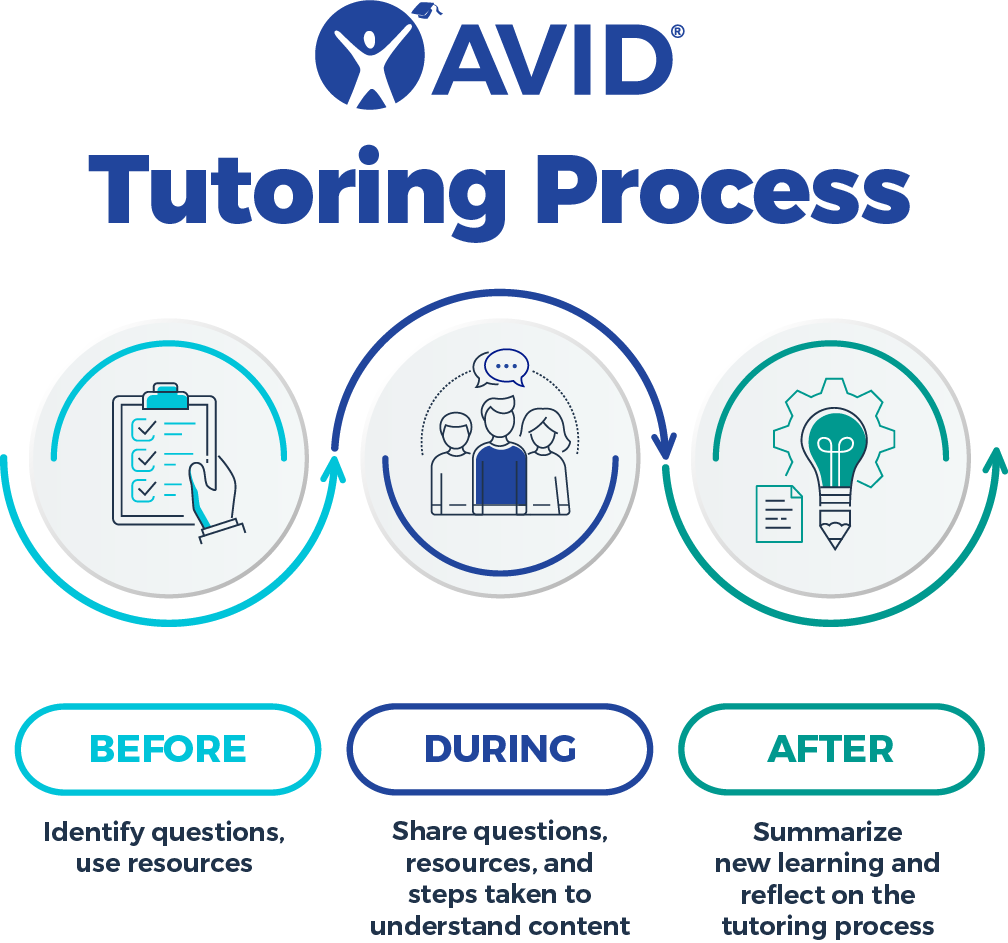Tutoring is a fundamental component of education, but did you know that many approaches to tutoring have little to no effect on student outcomes? AVID has logged over 100 million hours of tutoring in our four decades of experience and has developed differentiated tutoring models to support all students: individual or 1:1, Collaborative Study Groups with peers, AVID Elective Tutorials, and AVID Excel Scholar Groups.
Nationally, AVID serves millions of students. In our mission to close the opportunity gap and prepare all students for college and career readiness and success, we have developed and implemented a variety of tutoring models that encompass the following six principles.
AVID tutoring is:
- Structured: A process of repeatable steps allows for consistency across models; teachers, tutors, and students are trained on, reflective of, and continually coached in that process.
- Student-Centered: All tutorial models are built on a foundation of relational capacity so that students feel supported while seeking solutions.
- Inquiry-Based: Tutors and peers ask higher-order questions instead of offering answers.
- Collaborative: Peers use their collective agency to resolve points of confusion and support each other.
- Equitable: Defined roles and responsibilities ensure equal participation.
- Metacognitive: Students identify where they are confused, and then summarize their new learning and reflect on the process.
Phases of the Process

AVID’s tutoring process features a scaffolded and supportive approach to help students exercise their “inquiry muscles.” The process is divided into three parts: before, during, and after the session. Before the tutoring, students prepare by identifying a question they have about the material, using their resources and background knowledge to clearly articulate what they know and what they do not yet understand.
During tutoring, they present their specific question to the tutor or small group and share the steps they have taken to try to understand the problem. Next, the tutor and group members ask questions by revisiting content resources instead of offering solutions. This inquiry incorporates the use of academic language and vocabulary associated with the content area. Finally, they generate a list of generalized steps to their solutions to be used in future problem-solving.
After the session, students reflect on their learning, identifying which resources and strategies helped them better understand the concept or problem. Reflecting on the steps taken to find clarity develops their problem-solving abilities and builds their academic confidence.
Tutors
Tutors need to be trained to leverage inquiry and supplied with strategies and tools to support students in owning their learning. An essential outcome of tutor training is developing tutors’ understanding of the importance of creating a supportive learning environment through intentional strategies that foster trust, self-regulation, and effective communication. When strong rapport is built between students and tutors, students feel more comfortable taking academic risks, asking questions, and actively seeking the support they need to succeed.
Student Skill Development
Tutoring programs deliver the strongest educational impact when they accelerate learning and help students develop the academic skills needed to be future-ready. When the principles of AVID tutoring are implemented successfully, students develop skills, many of which are detailed below, that go beyond the basic goal of content retention.
- Deepened Content Knowledge: Students deepen their content knowledge in the academic area with which they struggle.
- Relational Capacity: Students learn the importance of relationships and building a network of support.
- Critical Thinking Skills: Students repeatedly practice metacognition in the before, during, and after phases of strategic tutoring.
- Fluency in Academic Language: Students practice speaking the academic language of the content area(s) in which they need support and tutoring.
- Inquiry: Students engage in academic conversations grounded in higher-order questioning.
- Process Identification: Students identify a sequence of steps to duplicate solutions to similar problems.
- Summary: Students write or speak about their academic learning to make connections between new learning and previous learning, their experiences, themselves, and/or their world.
- Reflection: Students reflect, verbally or in writing, to identify strengths and areas for continuous improvement within the process.
- Agency: Students own their learning as they internalize a process for advocating for themselves.
A structured process with clearly defined roles and responsibilities for students and trained tutors ensures that educators can implement effective tutoring. Incorporating the Six Tutoring Principles into individual, small-group, or collaborative tutoring sessions will support students’ current and future academic success while building their skills and agency.
AVID Connections
- Overview of Collaborative Study Groups: This 3-minute overview video explains the structure of Collaborative Study Groups (CSGs) and demonstrates how they can be used in content areas at any secondary grade level, 6–12.
- AVID Collaborative Study Groups: This one-pager provides an overview of the Collaborative Study Group process, which supports students in deepening their understanding through inquiry and applying their new learning in order to enhance classroom performance.
- Guiding Questions for Educators – Tutorials: These questions can be used to monitor, guide (when necessary), differentiate, support, and scaffold student inquiry during the tutorial process.
Extend Your Learning
- Do this, not that: Using ESSER funds for tutoring: This article by Dr. Lynn Kepp in District Administration covers five things that your district or school should be providing when it comes to high-dosage tutoring programs.
